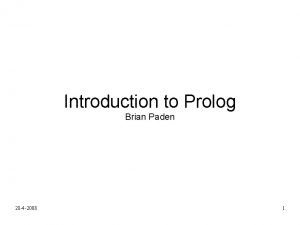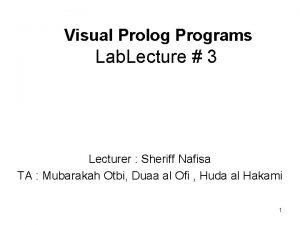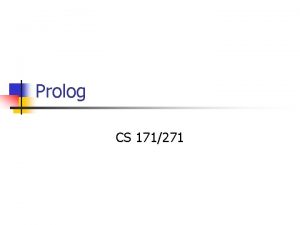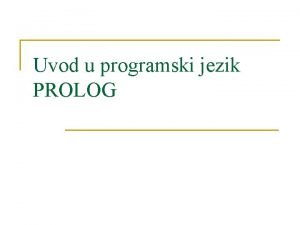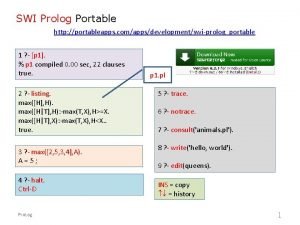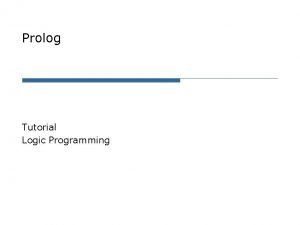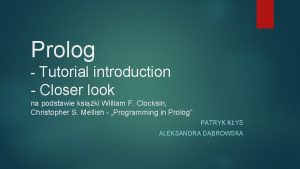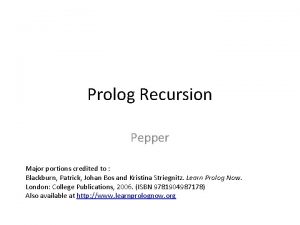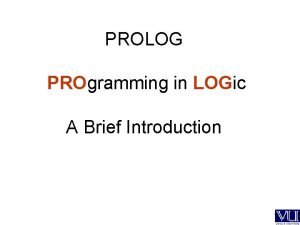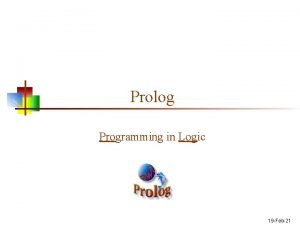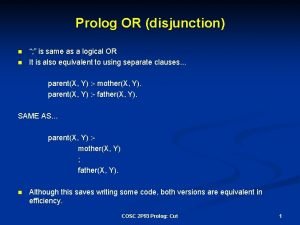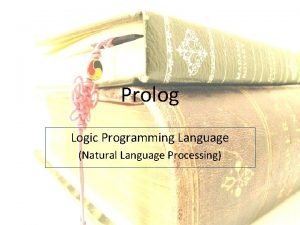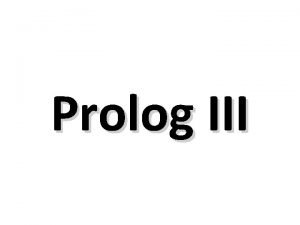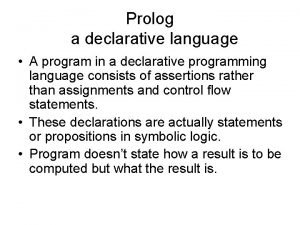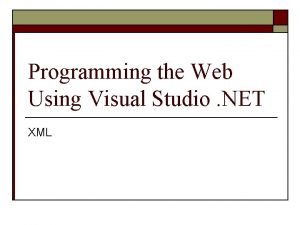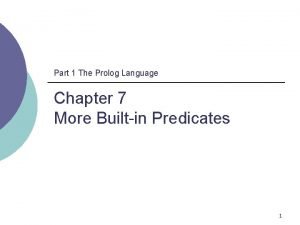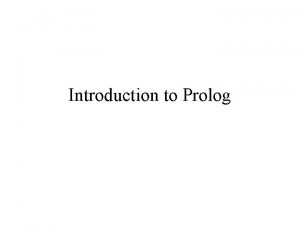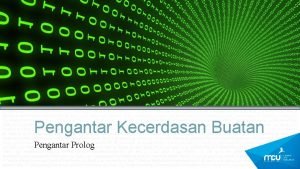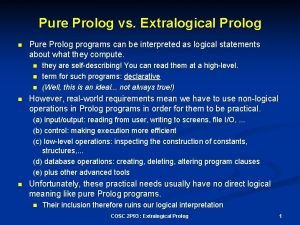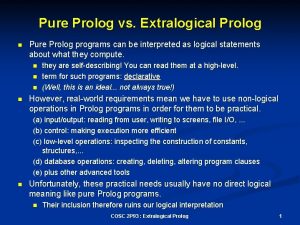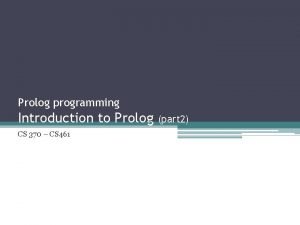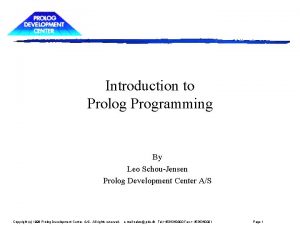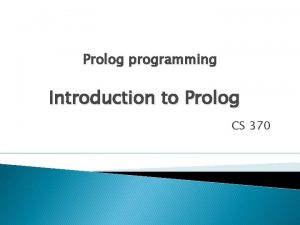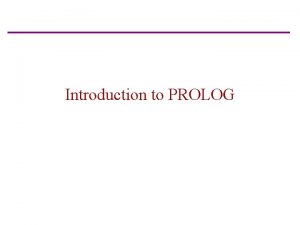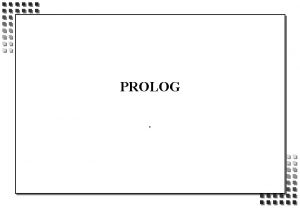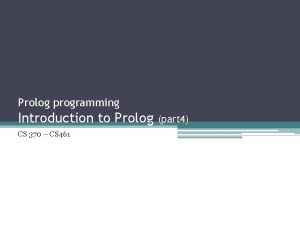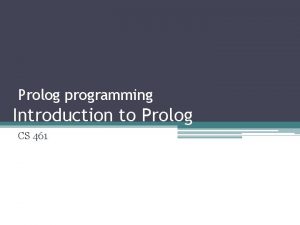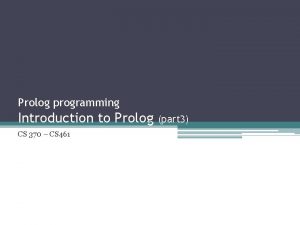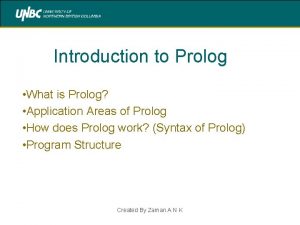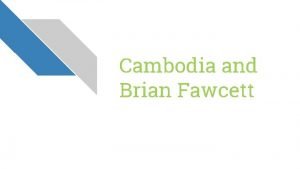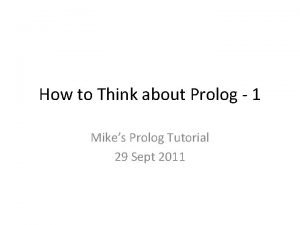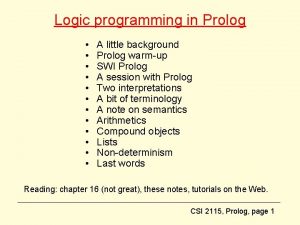Introduction to Prolog Brian Paden 28 4 2008

Introduction to Prolog Brian Paden 28 -4 -2008 1

History Creators: Alain Colmerauer & Phillipe Roussel Robert Kowalski University of Edinburgh Named by: Philippe Roussel University of Aix-Marseille 1972 programmation en logique First compiler: David H. D. Warren 28 -4 -2008 2

More History 1984 – Began working on standard 1987 – ISO Standard Group Formed 1995 – ISO Standard published Most current New version expected “by early 2000” 28 -4 -2008 3

Predicate Logic First order predicate calculus Propositions Resolution Atomic propositions & compound terms Inference rule Horn clauses Single atomic proposition on left side Empty left side 28 -4 -2008 4

Data Types Atom Letters or numbers 'x', 'long. Constant 17', '“Var”' Variable Start with uppercase 'X', 'Notan. Atom' Anonymous variable - '_' Fact 28 -4 -2008 'doesnt. Know( “Prolog”, brian ). ' 5

Variables Two states Instantiated Uninstantiated Variable has a set value Has not been assigned a value Closed-world assumption 28 -4 -2008 Only true if it can be proven 6

Data Structures Compound term Functor and arguments 'weird( prolog, yes ). ' Queries '? - good( presentation, brian )' Only returns 'yes' or 'no' Conjunction 28 -4 -2008 Multiply queries and facts 7

Special Compound Terms List Head Tail First element in list List containing everything else in list except the head Last element is empty list - '[]', '. ' - '[a, [b, [c]]]' == 'a. b. c. []' String Special list – all elements are atoms 28 -4 -2008 '[“This”, is, a, string, in, ”Prolog”]' 8
![More Lists Special list operators '[]' - Empty list '[X|Y]' – X is head, More Lists Special list operators '[]' - Empty list '[X|Y]' – X is head,](http://slidetodoc.com/presentation_image_h/d0bfaea9057cd46fbd94c9de6227699f/image-9.jpg)
More Lists Special list operators '[]' - Empty list '[X|Y]' – X is head, Y is tail '””' - convert list to list containing ascii values Recursive search for element of list member(X, [X|_]). member(X, [_|Y]) : - member(X, Y). ? - member(c, [a, b, c, d, e, f]). yes 28 -4 -2008 9

Built in Operators Compound construction ', ' - conjunction, '; ' - disjunction Comparison 'X = Y' – equality, 'X = 2' – inequality 'X == Y' – strict equality, 'X == 2' – strict inequality 'X < Y', 'X =< Y', - less than, less than equal to 'X > Y', 'X >= Y' – greater than, greater than equal to Arithmetic 28 -4 -2008 'X + Y', 'X - Y', 'X * Y', 'X / Y', 'X mod Y' 10

Arithmetic Operators that stand out '' - not, '=' - not equal '=<' - less equal, '>=' - greater equal Perform arithmetic 'is' 28 -4 -2008 ' Y = Y/X' – tests equality 'Y is Y/X' – assigns numeric value to Y Right hand side of 'is' must be algebraic 11

Looping No iteration, only recursion factorial(0, 1). factorial(N, F) : N>0, N 1 is N-1, factorial(N 1, F 1), F is N * F 1. ? - factorial(3, X). X=6 28 -4 -2008 12

I/O Special file Output 'tell(X). ' - creates/opens file 'telling(X). ' - gets open file name 'told' – closes file Input 'user' see, seeing, seen Misc 28 -4 -2008 'tab(X)', 'nl' 13

Backtracking User query Searches database for fact declaring it true Matching fact (head rule) found No matching fact found Mark place in database, move on to next goal Attempt to re-satisfy goal Undo last change and try again Cut Shortcuts backtracking 28 -4 -2008 '!' symbol 14

Backtracking in Action Database father(mary, george). father(john, george). father(sue, harry). father(george, edward). father(X) : - father(_, X). Query Result Y=george; Y=harry; Y=edward; no ? - father(Y). 28 -4 -2008 15
![Lists and Backtracking reverse([], []). reverse([Head|Tail], List) : reverse(Tail, Result), append(Result, [Head], List). trace. Lists and Backtracking reverse([], []). reverse([Head|Tail], List) : reverse(Tail, Result), append(Result, [Head], List). trace.](http://slidetodoc.com/presentation_image_h/d0bfaea9057cd46fbd94c9de6227699f/image-16.jpg)
Lists and Backtracking reverse([], []). reverse([Head|Tail], List) : reverse(Tail, Result), append(Result, [Head], List). trace. ? - reverse([a, b, c], Q). 28 -4 -2008 16
![Reverse Example (1) 1 Call: reverse([a, b, c], _6)? (2) 2 Call: reverse([b, c], Reverse Example (1) 1 Call: reverse([a, b, c], _6)? (2) 2 Call: reverse([b, c],](http://slidetodoc.com/presentation_image_h/d0bfaea9057cd46fbd94c9de6227699f/image-17.jpg)
Reverse Example (1) 1 Call: reverse([a, b, c], _6)? (2) 2 Call: reverse([b, c], _65636)? (3) 3 Call: reverse([c], _65646)? (4) 4 Call: reverse([], _65656)? (4) 4 Call: Exit: reverse([], []) (5) 4 Call: append([], [c], _65646)? (5) 4 Exit: append([], [c]) (3) 3 Exit: reverse([c], [c]) (6) 3 Call: append([c], [b], _65636)? (7) 4 Call: append([], [b], _25)? (7) 4 Exit: append([], [b]) (6) 3 Exit: append([c], [b], [c, b]) (2) 2 Exit: reverse([b, c], [c, b) (8) 2 Call: append([c, b], [a], _6)? (9) 3 Call: append([b], [a], _32)? (10) 4 Call: append([], [a], _39)? (10) 4 Exit: append([], [a]) (9) 3 Exit: append([b], [a], [b, a]) (8) 2 Exit: append([c, b], [a], [c, b, a]) (1) Exit: reverse([a, b, c], [c, b, a]) 28 -4 -2008 17

How to Cut Database sum_to(1, 1) : - !. sum_to(N, Res) : N 1 is N – 1, sum_to(N 1, Res), Res is Res + N. Result X = 15; no Query ? - sum_to(5, X). 28 -4 -2008 18

Useful Built in Predicates Conditional 'true', 'fail' – Always their namesakes 'atom(X)', 'integer(X)' – true if X is an atom or int 'atomic(X)' – X is not a variable 'asserta(X)' – adds clause X to start of database 'assertz(X)' – adds clause to end of database 'X =. . L' - Univ 28 -4 -2008 X is variable L is list where head is functor and tail is arguments 19

Example: Binary Tree Implementation Usage lookup(H, w(H, G, _, __, G) : - !. lookup(H, w(H 1, _, Before, _), G) : aless(H, H 1), lookup(H, Before, G). lookup(H, w(H 1, _, _, After), G) : not(aless(H, H 1)), lookup(H, After, G). ? - lookup(key, X, 582), lookup(val, X, 356). 28 -4 -2008 20
![Example: Quicksort partition([], _, []). partition([X|Xs], Pivot, Smalls, Bigs) : ( X @< Pivot Example: Quicksort partition([], _, []). partition([X|Xs], Pivot, Smalls, Bigs) : ( X @< Pivot](http://slidetodoc.com/presentation_image_h/d0bfaea9057cd46fbd94c9de6227699f/image-21.jpg)
Example: Quicksort partition([], _, []). partition([X|Xs], Pivot, Smalls, Bigs) : ( X @< Pivot -> Smalls = [X|Rest], partition(Xs, Pivot, Rest, Bigs) ; Bigs = [X|Rest], partition(Xs, Pivot, Smalls, Rest) ). quicksort([]) --> []. quicksort([X|Xs]) --> { partition(Xs, X, Smaller, Bigger) }, quicksort(Smaller), [X], quicksort(Bigger). 28 -4 -2008 21
![Example: Turing Machine turing(Tape 0, Tape) : perform(q 0, [], Ls, Tape 0, Rs), Example: Turing Machine turing(Tape 0, Tape) : perform(q 0, [], Ls, Tape 0, Rs),](http://slidetodoc.com/presentation_image_h/d0bfaea9057cd46fbd94c9de6227699f/image-22.jpg)
Example: Turing Machine turing(Tape 0, Tape) : perform(q 0, [], Ls, Tape 0, Rs), reverse(Ls, Ls 1), append(Ls 1, Rs, Tape). perform(qf, Ls, Rs) : - !. perform(Q 0, Ls, Rs 0, Rs) : symbol(Rs 0, Sym, Rs. Rest), once(rule(Q 0, Sym, Q 1, New. Sym, Action)), action(Action, Ls 0, Ls 1, [New. Sym|Rs. Rest], Rs 1), perform(Q 1, Ls, Rs 1, Rs). symbol([], b, []). symbol([Sym|Rs], Sym, Rs). action(left, Ls 0, Ls, Rs 0, Rs) : - left(Ls 0, Ls, Rs 0, Rs). action(stay, Ls, Rs). action(right, Ls 0, [Sym|Ls 0], [Sym|Rs], Rs). left([], Rs 0, [b|Rs 0]). left([L|Ls], Ls, Rs, [L|Rs]). 28 -4 -2008 22

Compilers ISO Compliant GNU Prolog SWI-Prolig http: //www. swi-prolog. org/ YAP http: //www. gprolog. org/ http: //www. ncc. up. pt/yap/ Visual Prolog (Turbo Prolog) 28 -4 -2008 http: //www. visual-prolog. com/ 23

Sources Clocksin, W. F and Mellish, C. S. Programming in Prolog. Berlin. Springer-Verlag: 1984 Sebesta, Robert W. Concepts of Programming Languages: Eighth Edition. 2007 http: //en. wikipedia. org/wiki/Prolog 28 -4 -2008 24
- Slides: 24
